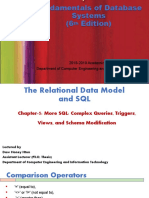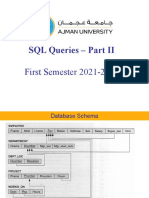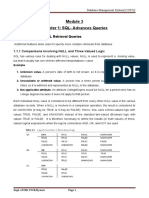Ch07 - More SQL; Complex Queries, Triggers, Views, and Schema Modification
Uploaded by
Faizan TanveerCh07 - More SQL; Complex Queries, Triggers, Views, and Schema Modification
Uploaded by
Faizan TanveerCHAPTER 7
More SQL: Complex Queries,
Triggers, Views, and Schema
Modification
Copyright © 2016 Ramez Elmasri and Shamkant B. Navathe Slide 7- 1
Chapter 7 Outline
More Complex SQL Retrieval Queries
Specifying Semantic Constraints as Assertions
and Actions as Triggers
Views (Virtual Tables) in SQL
Schema Modification in SQL
Copyright © 2016 Ramez Elmasri and Shamkant B. Navathe Slide 7- 3
More Complex SQL Retrieval
Queries
Additional features allow users to specify more
complex retrievals from database:
Nested queries, joined tables, and outer joins (in
the FROM clause), aggregate functions, and
grouping
Copyright © 2016 Ramez Elmasri and Shamkant B. Navathe Slide 7- 4
Comparisons Involving NULL
and Three-Valued Logic
Meanings of NULL
Unknown value
Unavailable or withheld value
Not applicable attribute
Each individual NULL value considered to be
different from every other NULL value
SQL uses a three-valued logic:
TRUE, FALSE, and UNKNOWN (like Maybe)
NULL = NULL comparison is avoided
Copyright © 2016 Ramez Elmasri and Shamkant B. Navathe Slide 7- 5
Comparisons Involving NULL
and Three-Valued Logic (cont’d.)
Copyright © 2016 Ramez Elmasri and Shamkant B. Navathe Slide 7- 6
Comparisons Involving NULL
and Three-Valued Logic (cont’d.)
SQL allows queries that check whether an
attribute value is NULL
IS or IS NOT NULL
Copyright © 2016 Ramez Elmasri and Shamkant B. Navathe Slide 7- 7
Nested Queries, Tuples,
and Set/Multiset Comparisons
Nested queries
Complete select-from-where blocks within WHERE
clause of another query
Outer query and nested subqueries
Comparison operator IN
Compares value v with a set (or multiset) of values
V
Evaluates to TRUE if v is one of the elements in V
Copyright © 2016 Ramez Elmasri and Shamkant B. Navathe Slide 7- 8
Nested Queries (cont’d.)
Copyright © 2016 Ramez Elmasri and Shamkant B. Navathe Slide 7- 9
Nested Queries (cont’d.)
Use tuples of values in comparisons
Place them within parentheses
Copyright © 2016 Ramez Elmasri and Shamkant B. Navathe Slide 7- 10
Nested Queries (cont’d.)
Use other comparison operators to compare a
single value v
= ANY (or = SOME) operator
Returns TRUE if the value v is equal to some value in
the set V and is hence equivalent to IN
Other operators that can be combined with ANY (or
SOME): >, >=, <, <=, and <>
ALL: value must exceed all values from nested
query
Copyright © 2016 Ramez Elmasri and Shamkant B. Navathe Slide 7- 11
Nested Queries (cont’d.)
Avoid potential errors and ambiguities
Create tuple variables (aliases) for all tables
referenced in SQL query
Copyright © 2016 Ramez Elmasri and Shamkant B. Navathe Slide 7- 11
Correlated Nested Queries
Queries that are nested using the = or IN
comparison operator can be collapsed into one
single block: E.g., Q16 can be written as:
Q16A: SELECT E.Fname, E.Lname
FROM EMPLOYEE AS E, DEPENDENT AS D
WHERE E.Ssn=D.Essn AND E.Sex=D.Sex
AND
E.Fname=D.Dependent_name;
Correlated nested query
Evaluated once for each tuple in the outer query
Copyright © 2016 Ramez Elmasri and Shamkant B. Navathe Slide 7- 13
The EXISTS and UNIQUE Functions
in SQL for correlating queries
EXISTS function
Check whether the result of a correlated nested
query is empty or not. They are Boolean functions
that return a TRUE or FALSE result.
EXISTS and NOT EXISTS
Typically used in conjunction with a correlated
nested query
SQL function UNIQUE(Q)
Returns TRUE if there are no duplicate tuples in
the result of query Q
Copyright © 2016 Ramez Elmasri and Shamkant B. Navathe Slide 7- 14
USE of EXISTS
Q7:
SELECT Fname, Lname
FROM Employee
WHERE EXISTS (SELECT *
FROM DEPENDENT
WHERE Ssn= Essn)
AND EXISTS (SELECT *
FROM Department
WHERE Ssn= Mgr_Ssn)
Copyright © 2016 Ramez Elmasri and Shamkant B. Navathe Slide 7- 15
USE OF NOT EXISTS
To achieve the “for all” (universal quantifier- see Ch.8) effect,
we use double negation this way in SQL:
Query: List first and last name of employees who work on
ALL projects controlled by Dno=5.
SELECT Fname, Lname
FROM Employee
WHERE NOT EXISTS ( (SELECT Pnumber
FROM PROJECT
WHERE Dno=5)
EXCEPT (SELECT Pno
FROM WORKS_ON
WHERE Ssn= ESsn)
The above is equivalent to double negation: List names of those
employees for whom there does NOT exist a project managed by
department no. 5 that they do NOT work on.
Copyright © 2016 Ramez Elmasri and Shamkant B. Navathe Slide 7- 16
Double Negation to accomplish “for
all” in SQL
Q3B: SELECT Lname, Fname
FROM EMPLOYEE
WHERE NOT EXISTS ( SELECT *
FROM WORKS_ON B
WHERE ( B.Pno IN ( SELECT Pnumber
FROM PROJECT
WHERE Dnum=5
AND
NOT EXISTS (SELECT *
FROM WORKS_ON C
WHERE C.Essn=Ssn
AND C.Pno=B.Pno )));
The above is a direct rendering of: List names of those employees for whom
there does NOT exist a project managed by department no. 5 that they
do NOT work on.
Copyright © 2016 Ramez Elmasri and Shamkant B. Navathe Slide 7- 16
Explicit Sets and Renaming of
Attributes in SQL
Can use explicit set of values in WHERE clause
Q17: SELECT DISTINCT Essn
FROM WORKS_ON
WHERE Pno IN (1, 2, 3);
Use qualifier AS followed by desired new name
Rename any attribute that appears in the result of
a query
Copyright © 2016 Ramez Elmasri and Shamkant B. Navathe Slide 7- 18
Specifying Joined Tables in the
FROM Clause of SQL
Joined table
Permits users to specify a table resulting from a
join operation in the FROM clause of a query
The FROM clause in Q1A
Contains a single joined table. JOIN may also be
called INNER JOIN
Copyright © 2016 Ramez Elmasri and Shamkant B. Navathe Slide 7- 19
Different Types of JOINed Tables in
SQL
Specify different types of join
NATURAL JOIN
Various types of OUTER JOIN (LEFT, RIGHT,
FULL )
NATURAL JOIN on two relations R and S
No join condition specified
Is equivalent to an implicit EQUIJOIN condition for
each pair of attributes with same name from R and
S
Copyright © 2016 Ramez Elmasri and Shamkant B. Navathe Slide 7- 20
NATURAL JOIN
Rename attributes of one relation so it can be joined with
another using NATURAL JOIN:
Q1B: SELECT Fname, Lname, Address
FROM (EMPLOYEE NATURAL JOIN
(DEPARTMENT AS DEPT (Dname, Dno, Mssn,
Msdate)))
WHERE Dname=‘Research’;
The above works with EMPLOYEE.Dno = DEPT.Dno as an
implicit join condition
Copyright © 2016 Ramez Elmasri and Shamkant B. Navathe Slide 7- 20
INNER and OUTER Joins
INNER JOIN (versus OUTER JOIN)
Default type of join in a joined table
Tuple is included in the result only if a matching tuple exists
in the other relation
LEFT OUTER JOIN
Every tuple in left table must appear in result
If no matching tuple
Padded with NULL values for attributes of right table
RIGHT OUTER JOIN
Every tuple in right table must appear in result
If no matching tuple
Padded with NULL values for attributes of left table
Copyright © 2016 Ramez Elmasri and Shamkant B. Navathe Slide 7- 22
Example: LEFT OUTER JOIN
SELECT E.Lname AS Employee_Name
S.Lname AS Supervisor_Name
FROM Employee AS E LEFT OUTER JOIN EMPLOYEE AS S
ON E.Super_ssn = S.Ssn)
ALTERNATE SYNTAX:
SELECT E.Lname , S.Lname
FROM EMPLOYEE E, EMPLOYEE S
WHERE E.Super_ssn + = S.Ssn
Copyright © 2016 Ramez Elmasri and Shamkant B. Navathe Slide 7- 22
Multiway JOIN in the FROM clause
FULL OUTER JOIN – combines result if LEFT
and RIGHT OUTER JOIN
Can nest JOIN specifications for a multiway join:
Q2A: SELECT Pnumber, Dnum, Lname, Address, Bdate
FROM ((PROJECT JOIN DEPARTMENT ON
Dnum=Dnumber) JOIN EMPLOYEE ON
Mgr_ssn=Ssn)
WHERE Plocation=‘Stafford’;
Copyright © 2016 Ramez Elmasri and Shamkant B. Navathe Slide 7- 23
Aggregate Functions in SQL
Used to summarize information from multiple
tuples into a single-tuple summary
Built-in aggregate functions
COUNT, SUM, MAX, MIN, and AVG
Grouping
Create subgroups of tuples before summarizing
To select entire groups, HAVING clause is used
Aggregate functions can be used in the SELECT
clause or in a HAVING clause
Copyright © 2016 Ramez Elmasri and Shamkant B. Navathe Slide 7- 24
Renaming Results of Aggregation
Following query returns a single row of computed values
from EMPLOYEE table:
Q19: SELECT SUM (Salary), MAX (Salary), MIN (Salary), AVG
(Salary)
FROM EMPLOYEE;
The result can be presented with new names:
Q19A: SELECT SUM (Salary) AS Total_Sal, MAX (Salary) AS
Highest_Sal, MIN (Salary) AS Lowest_Sal, AVG
(Salary) AS Average_Sal
FROM EMPLOYEE;
Copyright © 2016 Ramez Elmasri and Shamkant B. Navathe Slide 7- 25
Aggregate Functions in SQL (cont’d.)
NULL values are discarded when aggregate
functions are applied to a particular column
Copyright © 2016 Ramez Elmasri and Shamkant B. Navathe Slide 7- 26
Aggregate Functions on Booleans
SOME and ALL may be applied as functions on
Boolean Values.
SOME returns true if at least one element in the
collection is TRUE (similar to OR)
ALL returns true if all of the elements in the
collection are TRUE (similar to AND)
Copyright © 2016 Ramez Elmasri and Shamkant B. Navathe Slide 7- 27
Grouping: The GROUP BY Clause
Partition relation into subsets of tuples
Based on grouping attribute(s)
Apply function to each such group independently
GROUP BY clause
Specifies grouping attributes
COUNT (*) counts the number of rows in the
group
Copyright © 2016 Ramez Elmasri and Shamkant B. Navathe Slide 7- 28
Examples of GROUP BY
The grouping attribute must appear in the SELECT
clause:
Q24: SELECT Dno, COUNT (*), AVG (Salary)
FROM EMPLOYEE
GROUP BY Dno;
If the grouping attribute has NULL as a possible value,
then a separate group is created for the null value (e.g.,
null Dno in the above query)
GROUP BY may be applied to the result of a JOIN:
Q25: SELECT Pnumber, Pname, COUNT (*)
FROM PROJECT, WORKS_ON
WHERE Pnumber=Pno
GROUP BY Pnumber, Pname;
Copyright © 2016 Ramez Elmasri and Shamkant B. Navathe Slide 7- 29
Grouping: The GROUP BY and
HAVING Clauses (cont’d.)
HAVING clause
Provides a condition to select or reject an entire
group:
Query 26. For each project on which more than two employees work,
retrieve the project number, the project name, and the number of
employees who work on the project.
Q26: SELECT Pnumber, Pname, COUNT (*)
FROM PROJECT, WORKS_ON
WHERE Pnumber=Pno
GROUP BY Pnumber, Pname
HAVING COUNT (*) > 2;
Copyright © 2016 Ramez Elmasri and Shamkant B. Navathe Slide 7- 31
Combining the WHERE and the
HAVING Clause
Consider the query: we want to count the total number of
employees whose salaries exceed $40,000 in each
department, but only for departments where more than
five employees work.
INCORRECT QUERY:
SELECT Dno, COUNT (*)
FROM EMPLOYEE
WHERE Salary>40000
GROUP BY Dno
HAVING COUNT (*) > 5;
Copyright © 2016 Ramez Elmasri and Shamkant B. Navathe Slide 7- 31
Combining the WHERE and the
HAVING Clause (continued)
Correct Specification of the Query:
Note: the WHERE clause applies tuple by tuple
whereas HAVING applies to entire group of tuples
Copyright © 2016 Ramez Elmasri and Shamkant B. Navathe Slide 7- 32
Use of WITH
The WITH clause allows a user to define a table
that will only be used in a particular query (not
available in all SQL implementations)
Used for convenience to create a temporary
“View” and use that immediately in a query
Allows a more straightforward way of looking a
step-by-step query
Copyright © 2016 Ramez Elmasri and Shamkant B. Navathe Slide 7- 33
Example of WITH
See an alternate approach to doing Q28:
Q28’: WITH BIGDEPTS (Dno) AS
( SELECT Dno
FROM EMPLOYEE
GROUP BY Dno
HAVING COUNT (*) > 5)
SELECT Dno, COUNT (*)
FROM EMPLOYEE
WHERE Salary>40000 AND Dno IN BIGDEPTS
GROUP BY Dno;
Copyright © 2016 Ramez Elmasri and Shamkant B. Navathe Slide 7- 34
Use of CASE
SQL also has a CASE construct
Used when a value can be different based on
certain conditions.
Can be used in any part of an SQL query where a
value is expected
Applicable when querying, inserting or updating
tuples
Copyright © 2016 Ramez Elmasri and Shamkant B. Navathe Slide 7- 35
EXAMPLE of use of CASE
The following example shows that employees are
receiving different raises in different departments
(A variation of the update U6)
U6’: UPDATE EMPLOYEE
SET Salary =
CASE WHEN Dno = 5THEN Salary + 2000
WHEN Dno = 4THEN Salary + 1500
WHEN Dno = 1THEN Salary + 3000
Copyright © 2016 Ramez Elmasri and Shamkant B. Navathe Slide 7- 36
Recursive Queries in SQL
An example of a recursive relationship between
tuples of the same type is the relationship
between an employee and a supervisor.
This relationship is described by the foreign key
Super_ssn of the EMPLOYEE relation
An example of a recursive operation is to retrieve all supervisees of
a supervisory employee e at all levels—that is, all employees e
directly supervised by e, all employees e’ directly supervised by each
employee e, all employees e directly supervised by each employee
e, and so on. Thus the CEO would have each employee in the
company as a supervisee in the resulting table. Example shows such
table SUP_EMP with 2 columns (Supervisor,Supervisee(any level)):
Copyright © 2016 Ramez Elmasri and Shamkant B. Navathe Slide 7- 37
An EXAMPLE of RECURSIVE Query
Q29: WITH RECURSIVE SUP_EMP (SupSsn, EmpSsn) AS
SELECT SupervisorSsn, Ssn
FROM EMPLOYEE
UNION
SELECT E.Ssn, S.SupSsn
FROM EMPLOYEE AS E, SUP_EMP AS S
WHERE E.SupervisorSsn = S.EmpSsn)
SELECT *
FROM SUP_EMP;
The above query starts with an empty SUP_EMP and
successively builds SUP_EMP table by computing
immediate supervisees first, then second level
supervisees, etc. until a fixed point is reached and no
more supervisees can be added
Copyright © 2016 Ramez Elmasri and Shamkant B. Navathe Slide 7- 38
EXPANDED Block Structure of SQL
Queries
Copyright © 2016 Ramez Elmasri and Shamkant B. Navathe Slide 7- 40
Specifying Constraints as Assertions
and Actions as Triggers
Semantic Constraints: The following are beyond
the scope of the EER and relational model
CREATE ASSERTION
Specify additional types of constraints outside
scope of built-in relational model constraints
CREATE TRIGGER
Specify automatic actions that database system
will perform when certain events and conditions
occur
Copyright © 2016 Ramez Elmasri and Shamkant B. Navathe Slide 7- 41
Specifying General Constraints as
Assertions in SQL
CREATE ASSERTION
Specify a query that selects any tuples that violate
the desired condition
Use only in cases where it goes beyond a simple
CHECK which applies to individual attributes and
domains
Copyright © 2016 Ramez Elmasri and Shamkant B. Navathe Slide 7- 41
Introduction to Triggers in SQL
CREATE TRIGGER statement
Used to monitor the database
Typical trigger has three components which make
it a rule for an “active database “ (more on active
databases in section 26.1) :
Event(s)
Condition
Action
Copyright © 2016 Ramez Elmasri and Shamkant B. Navathe Slide 7- 43
USE OF TRIGGERS
AN EXAMPLE with standard Syntax.(Note : other
SQL implementations like PostgreSQL use a
different syntax.)
R5:
CREATE TRIGGER SALARY_VIOLATION
BEFORE INSERT OR UPDATE OF Salary, Supervisor_ssn ON
EMPLOYEE
FOR EACH ROW
WHEN (NEW.SALARY > ( SELECT Salary FROM EMPLOYEE
WHERE Ssn = NEW. Supervisor_Ssn))
INFORM_SUPERVISOR (NEW.Supervisor.Ssn, New.Ssn)
Copyright © 2016 Ramez Elmasri and Shamkant B. Navathe Slide 7- 44
Views (Virtual Tables) in SQL
Concept of a view in SQL
Single table derived from other tables called the
defining tables
Considered to be a virtual table that is not
necessarily populated
Copyright © 2016 Ramez Elmasri and Shamkant B. Navathe Slide 7- 45
Specification of Views in SQL
CREATE VIEW command
Give table name, list of attribute names, and a query to
specify the contents of the view
In V1, attributes retain the names from base tables. In
V2, attributes are assigned names
Copyright © 2016 Ramez Elmasri and Shamkant B. Navathe Slide 7- 46
Specification of Views in SQL
(cont’d.)
Once a View is defined, SQL queries can use the
View relation in the FROM clause
View is always up-to-date
Responsibility of the DBMS and not the user
DROP VIEW command
Dispose of a view
Copyright © 2016 Ramez Elmasri and Shamkant B. Navathe Slide 7- 47
View Implementation, View Update,
and Inline Views
Complex problem of efficiently implementing a
view for querying
Strategy1: Query modification approach
Compute the view as and when needed. Do not
store permanently
Modify view query into a query on underlying base
tables
Disadvantage: inefficient for views defined via
complex queries that are time-consuming to
execute
Copyright © 2016 Ramez Elmasri and Shamkant B. Navathe Slide 7- 48
View Materialization
Strategy 2: View materialization
Physically create a temporary view table when the
view is first queried
Keep that table on the assumption that other
queries on the view will follow
Requires efficient strategy for automatically updating
the view table when the base tables are updated
Incremental update strategy for materialized
views
DBMS determines what new tuples must be inserted,
deleted, or modified in a materialized view table
Copyright © 2016 Ramez Elmasri and Shamkant B. Navathe Slide 7- 49
View Materialization (contd.)
Multiple ways to handle materialization:
immediate update strategy updates a view as
soon as the base tables are changed
lazy update strategy updates the view when
needed by a view query
periodic update strategy updates the view
periodically (in the latter strategy, a view query
may get a result that is not up-to-date). This is
commonly used in Banks, Retail store operations,
etc.
Copyright © 2016 Ramez Elmasri and Shamkant B. Navathe Slide 7- 49
View Update
Update on a view defined on a single table without any
aggregate functions
Can be mapped to an update on underlying base table-
possible if the primary key is preserved in the view
Update not permitted on aggregate views. E.g.,
UV2: UPDATE DEPT_INFO
SET Total_sal=100000
WHERE Dname=‘Research’;
cannot be processed because Total_sal is a computed value
in the view definition
Copyright © 2016 Ramez Elmasri and Shamkant B. Navathe Slide 7- 51
View Update and Inline Views
View involving joins
Often not possible for DBMS to determine which
of the updates is intended
Clause WITH CHECK OPTION
Must be added at the end of the view definition if a
view is to be updated to make sure that tuples
being updated stay in the view
In-line view
Defined in the FROM clause of an SQL query (e.g.,
we saw its used in the WITH example)
Copyright © 2016 Ramez Elmasri and Shamkant B. Navathe Slide 7- 51
Views as authorization mechanism
SQL query authorization statements (GRANT and
REVOKE) are described in detail in Chapter 30
Views can be used to hide certain attributes or
tuples from unauthorized users
E.g., For a user who is only allowed to see
employee information for those who work for
department 5, he may only access the view
DEPT5EMP:
CREATE VIEW DEPT5EMP AS
SELECT *
FROM EMPLOYEE
WHERE Dno = 5;
Copyright © 2016 Ramez Elmasri and Shamkant B. Navathe Slide 7- 52
Schema Change Statements in SQL
Schema evolution commands
DBA may want to change the schema while the
database is operational
Does not require recompilation of the database
schema
Copyright © 2016 Ramez Elmasri and Shamkant B. Navathe Slide 7- 54
The DROP Command
DROP command
Used to drop named schema elements, such as
tables, domains, or constraint
Drop behavior options:
CASCADE and RESTRICT
Example:
DROP SCHEMA COMPANY CASCADE;
This removes the schema and all its elements
including tables,views, constraints, etc.
Copyright © 2016 Ramez Elmasri and Shamkant B. Navathe Slide 7- 55
The ALTER table command
Alter table actions include:
Adding or dropping a column (attribute)
Changing a column definition
Adding or dropping table constraints
Example:
ALTER TABLE COMPANY.EMPLOYEE ADD
COLUMN Job VARCHAR(12);
Copyright © 2016 Ramez Elmasri and Shamkant B. Navathe Slide 7- 56
Adding and Dropping Constraints
Change constraints specified on a table
Add or drop a named constraint
Copyright © 2016 Ramez Elmasri and Shamkant B. Navathe Slide 7- 57
Dropping Columns, Default Values
To drop a column
Choose either CASCADE or RESTRICT
CASCADE would drop the column from views etc.
RESTRICT is possible if no views refer to it.
ALTER TABLE COMPANY.EMPLOYEE DROP COLUMN
Address CASCADE;
Default values can be dropped and altered :
ALTER TABLE COMPANY.DEPARTMENT ALTER COLUMN Mgr_ssn
DROP DEFAULT;
ALTER TABLE COMPANY.DEPARTMENT ALTER COLUMN Mgr_ssn SET
DEFAULT ‘333445555’;
Copyright © 2016 Ramez Elmasri and Shamkant B. Navathe Slide 7- 57
Table 7.2 Summary of SQL
Syntax
continued on next slide
Copyright © 2016 Ramez Elmasri and Shamkant B. Navathe Slide 7- 59
Table 7.2 (continued)
Summary of SQL Syntax
Copyright © 2016 Ramez Elmasri and Shamkant B. Navathe Slide 7- 60
Summary
Complex SQL:
Nested queries, joined tables (in the FROM
clause), outer joins, aggregate functions, grouping
Handling semantic constraints with CREATE
ASSERTION and CREATE TRIGGER
CREATE VIEW statement and materialization
strategies
Schema Modification for the DBAs using ALTER
TABLE , ADD and DROP COLUMN, ALTER
CONSTRAINT etc.
Copyright © 2016 Ramez Elmasri and Shamkant B. Navathe Slide 7- 61
You might also like
- Ch06-The Relational Algebra and Calculus (Compatibility Mode) (Repaired)No ratings yetCh06-The Relational Algebra and Calculus (Compatibility Mode) (Repaired)80 pages
- Chapter 4 The Relational Algebra and CalculusNo ratings yetChapter 4 The Relational Algebra and Calculus60 pages
- 23-M4-File Organization - Single level indexing-09-09-2024No ratings yet23-M4-File Organization - Single level indexing-09-09-202481 pages
- Dbms Int302 Unit#3 B SQL Part II 2021 1No ratings yetDbms Int302 Unit#3 B SQL Part II 2021 146 pages
- SQL: Advanced Queries: Module - Iii Notes Dbms - 15Cs53 V Sem Cse/IseNo ratings yetSQL: Advanced Queries: Module - Iii Notes Dbms - 15Cs53 V Sem Cse/Ise18 pages
- SQL-99 SchemaDefinition- Constraints- and Queries and Views.pptNo ratings yetSQL-99 SchemaDefinition- Constraints- and Queries and Views.ppt74 pages
- Basic Queries in SQL:: SELECT FROM WHERENo ratings yetBasic Queries in SQL:: SELECT FROM WHERE13 pages
- BASIC SQL: Schema Definition, Basic Constraints, and QueriesNo ratings yetBASIC SQL: Schema Definition, Basic Constraints, and Queries70 pages
- Advanced SAS Interview Questions You'll Most Likely Be AskedFrom EverandAdvanced SAS Interview Questions You'll Most Likely Be AskedNo ratings yet
- DB2 11.1 for LUW: SQL Basic Training for Application DevelopersFrom EverandDB2 11.1 for LUW: SQL Basic Training for Application DevelopersNo ratings yet
- Inner Join: This Join Returns Rows When There Is at Least One Match in Both The TablesNo ratings yetInner Join: This Join Returns Rows When There Is at Least One Match in Both The Tables10 pages
- HT TP: //qpa Pe R.W But .Ac .In: 2010 Advanced Database ManagementNo ratings yetHT TP: //qpa Pe R.W But .Ac .In: 2010 Advanced Database Management7 pages
- How To Modify CTS Transport Number Range (ABAP)No ratings yetHow To Modify CTS Transport Number Range (ABAP)2 pages
- RDBMS-Day3: - Basic DDL Statements - DML Statements - Aggregate FunctionsNo ratings yetRDBMS-Day3: - Basic DDL Statements - DML Statements - Aggregate Functions61 pages
- SQL MCQ (Multiple Choice Questions) - JavatpointNo ratings yetSQL MCQ (Multiple Choice Questions) - Javatpoint26 pages
- EBSPROD - Switchover - Switchback - Version 1.0No ratings yetEBSPROD - Switchover - Switchback - Version 1.020 pages
- Ch06-The Relational Algebra and Calculus (Compatibility Mode) (Repaired)Ch06-The Relational Algebra and Calculus (Compatibility Mode) (Repaired)
- 23-M4-File Organization - Single level indexing-09-09-202423-M4-File Organization - Single level indexing-09-09-2024
- SQL: Advanced Queries: Module - Iii Notes Dbms - 15Cs53 V Sem Cse/IseSQL: Advanced Queries: Module - Iii Notes Dbms - 15Cs53 V Sem Cse/Ise
- SQL-99 SchemaDefinition- Constraints- and Queries and Views.pptSQL-99 SchemaDefinition- Constraints- and Queries and Views.ppt
- BASIC SQL: Schema Definition, Basic Constraints, and QueriesBASIC SQL: Schema Definition, Basic Constraints, and Queries
- Advanced SAS Interview Questions You'll Most Likely Be AskedFrom EverandAdvanced SAS Interview Questions You'll Most Likely Be Asked
- DB2 11.1 for LUW: SQL Basic Training for Application DevelopersFrom EverandDB2 11.1 for LUW: SQL Basic Training for Application Developers
- Inner Join: This Join Returns Rows When There Is at Least One Match in Both The TablesInner Join: This Join Returns Rows When There Is at Least One Match in Both The Tables
- HT TP: //qpa Pe R.W But .Ac .In: 2010 Advanced Database ManagementHT TP: //qpa Pe R.W But .Ac .In: 2010 Advanced Database Management
- RDBMS-Day3: - Basic DDL Statements - DML Statements - Aggregate FunctionsRDBMS-Day3: - Basic DDL Statements - DML Statements - Aggregate Functions

























































































